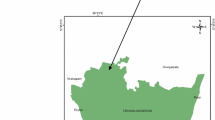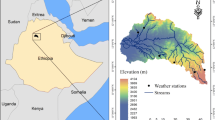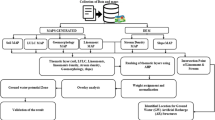Abstract
The major source of drinking water is Groundwater for human life. The current study utilized the geospatial techniques, to identify the groundwater potential zones in Chennai region. The calculable parameters used to conduct this study such as soil, land use/land cover, geomorphology, geology, slope, rainfall, lineament, drainage density, lineament density and NDVI which has been derived to identify the groundwater potentiality in the research area. The weighted overlay technique determines the influence of various parameters based on the assigned weights. The study highlighted the groundwater potential zones in five categories such as very low, low, moderate, high and very high. The result reveals that western and south western zones of the Chennai region records 60% dominant in groundwater. The study will also enhance the stakeholders for the purpose of planning, resource management and other developments in the study area.
Access this chapter
Tax calculation will be finalised at checkout
Purchases are for personal use only
Similar content being viewed by others
References
Bagyaraj, M., Ramkumar, T., Venkatramanan, S., & Gurugnanam, B. (2013). Application of remote sensing and GIS analysis for identifying groundwater potential zone in parts of Kodaikanal Taluk, South India. Frontier Earth Science, 07, 65–75.
Burrough, P. A. (1986). Principles of geographic information systems for land resource assessment. Oxford: Oxford University Press.
CGWB. (2017). Central groundwater board—a technical report series. Government of India
CGWB. (2019). Central groundwater board—a technical report series. Government of India.
Chen, F.-W., Liu, C.-W. (2012). Estimation of the spatial rainfall distribution using inverse distance weighting (IDW) in the middle of Taiwan. Paddy and Water Environment. 10.10.1007/s10333-012-0319-1
Chilton, P. J., Lawrence, A. R., Stuart, M. E. (1995). The impact of tropical agriculture on groundwater quality. In: Nash, H., McCall, G.J.H. (eds.) Groundwater quality
Chowdhury, A., Jha, M. K., & Chowdary, V. M. (2010). Delineation of groundwater recharge zones and identification of artificial recharge sites in West Medinipur district, West Bengal, using RS, GIS and MCDM techniques. Environmental Earth Sciences, 9, 1209–1222.
Haridas, V.R., Aravindan, S., Girish, G. (1998). Remote sensing and its applications for groundwater favorable area identification. Quarterly Journal of GARC, 06, 18–22
Howard, K. W. F. (2002). Urban groundwater issues—an introduction. Current problems of hydrogeology in urban areas, urban agglomerates and industrial centres. Nato Science Series (Series IV: Earth and Environmental Sciences) (Vol. 08, pp 1–15)
Imran, A.D., Sankar, K., Mithas, A. D. (2010). Remote sensing technology and geographic information system modeling: an integrated approach towards the mapping of groundwater potential zones in Hardrock terrain, Mamundiyar basin. Journal of Hydrology, 394, 285–295
Kanagaraj, G., Suganthi, S., Elango, L., Magesh, N. S. (2019). Assessment of groundwater potential zones in Vellore district, Tamil Nadu, India using geospatial techniques. Earth Science Informatics, 12, 211–223
Kumar, T., Gautam, A. K., & Kumar, T. (2014). Appraising the accuracy of GIS based multi-criteria decision-making technique for delineation of groundwater potential zones. Water Resources Management, 28, 4449–4466
Magesh, N. S., Chandrasekar, N., Soundranayagam, J.P. (2012). Delineation of groundwater potential zones in Theni district, Tamil Nadu, using remote sensing. GIS and MIF techniques. Geoscience Frontiers, 3(2), 189–196
Moharir, K., Pande, C., Patil, S. (2017). Inverse modeling of aquifer parameters in basaltic rock with the help of pumping test method using MODFLOW software. Geoscience Front Elsevier Journal, 8, 1–13
Nag, S. K., Ghosh, P. (2013). Delineation of groundwater potential zone in Chhatna Block, Bankura District, West Bengal, India using remote sensing and GIS techniques. Environmental Earth Science, 70, 2115–2127
Nagarajan, M., & Singh, S. (2009). Assessment of groundwater potential zones using GIS technique. Journal Indian Society of Remote Sensing, 37, 69–77.
Oh, H.J., Kim, Y.S., Choi, J.K., Park, E. & Lee, S. (2011). GIS mapping of regional probabilistic groundwater potential in the area of Pohang City, Korea. Journal of Hydrology, 399, 158–172
Patra, S., & Mishra, P. (2018). Delineation of groundwater potential zone for sustainable development: A case study from Ganga alluvial plain covering Hooghly district of India using remote sensing, geographic information system and analytic hierarchy process. Journal of Cleaner Production, 172, 2485–2502.
Sander, P., Chesley, M. M., & Minor, T. B. (1996). Groundwater assessment using remote sensing and GIS in a rural groundwater project in ghana: lessons learned. Hydrogeology Journal, 04(3), 40–49.
Saraf, A. K., Choudhury, P. R. (1998). Integrated remote sensing and GIS for groundwater exploration and identification of artificial recharge sites. International Journal of Remote Sensing, 19(10), 1825–1841
Selvam, S., Magesh, N. S., Chidambaram, S., Rajamanickam, M., & Sashikkumar, M. C. (2015). A GIS based identification of groundwater recharge potential zones using RS and IF technique: A case study in Ottapidaramtaluk, Tuticorin district, Tamil Nadu. Environmental Earth Science, 73, 3785–3799.
Sener, E., Davraz, A., Ozcelik, M. (2005). An integration of GIS and remote sensing in groundwater investigations: a case study in Burdur, Turkey. Hydrogeology Journal, 13, 826–834
Takem, G. E., Ayonghe, S. N., Chandrasekharam, D., Ntchancho, R., Ako, A.A., Mouncherou, O. F., Thambidurai, P. (2011). Controls on groundwater chemistry in a highly urbanised coastal area. International Journal of Environmental Research, 5(2), 475–490
Takem, G. E., Chandrasekharam, D., Ayonghe, S. N., & Thambidurai, P. (2010). Pollution characteristics of alluvial ground water from springs and bore wells in semi-urban informal settlements of Douala, Cameroon, Western Africa. Journal of Environmental Earth Sciences, 61(2), 287–298.
Thambidurai, P., Chandrasekharam, D., & Chandrashekhar, A. K. (2014). Hydrogeochemistry and groundwater quality in Champhai, Mizoram, North Eastern India. Earth Sciences and Engineering, 7(2), 421–425.
Thambidurai, P., Chandrashekhar, A. K., & Chandrasekharam, D. (2013). Geochemical signature of arsenic-contaminated groundwater in Barak Valley (Assam) and surrounding areas, northeastern India. Procedia Earth and Planetary Science, 07, 834–837.
Todd, D. K., Mays, L. W. (1980). Groundwater hydrology, 3rd edn. (p. 656). New York: Wiley.
UNESCO. (2000). Groundwater UNESCO Environmental Development Briefs.
Varma, H. N., Tiwari, K. N. (1995). Current status and prospectus of rainwater harvesting. Indian National Committee on Hydrology (INCOH). National Institute of Hydrology, Roorkee, India, (Scientific contribution No. INCOH/SAR-95/3).
Yeh, H. F., Cheng, Y. S., Lin, H. I., & Lee, C. H. (2016). Mapping groundwater recharge potential zone using a GIS approach in Hualian River, Taiwan. Sustainable Environmental Resources, 26, 33–43.
Acknowledgements
The authors would like to acknowledge the Geological Survey of India, Indian Meteorological Department and National Bureau of Soil Survey for their resources. We extend our thanks to anonymous reviewers for their suggestions and comments to improve the quality of the manuscript.
Author information
Authors and Affiliations
Corresponding author
Editor information
Editors and Affiliations
Rights and permissions
Copyright information
© 2021 Springer Nature Switzerland AG
About this chapter
Cite this chapter
Vignesh, K.S., Thambidurai, P., Selvan, V.N.I. (2021). Geospatial Assessment of Groundwater Potential Zone in Chennai Region, Tamil Nadu, India. In: Adhikary, P.P., Shit, P.K., Santra, P., Bhunia, G.S., Tiwari, A.K., Chaudhary, B.S. (eds) Geostatistics and Geospatial Technologies for Groundwater Resources in India. Springer Hydrogeology. Springer, Cham. https://doi.org/10.1007/978-3-030-62397-5_9
Download citation
DOI: https://doi.org/10.1007/978-3-030-62397-5_9
Published:
Publisher Name: Springer, Cham
Print ISBN: 978-3-030-62396-8
Online ISBN: 978-3-030-62397-5
eBook Packages: Earth and Environmental ScienceEarth and Environmental Science (R0)




